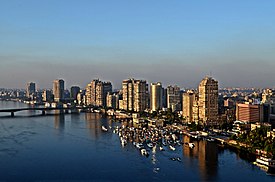<<GotoNote

Giza (/ˈɡiːzə/; sometimes spelled Gizah or Jizah; Arabic: الجيزة al-Jīzah, Egyptian Arabic pronunciation: [el ˈgiːze]; Coptic: ϯⲡⲉⲣⲥⲓⲥ, ⲅⲓⲍⲁ Tipersis, Giza) is the third-largest city in Egypt and the capital of the Giza Governorate. It is located on the west bank of the Nile, 4.9 km (3 mi) southwest of central Cairo. Along with Cairo Governorate, Shubra El Kheima, Helwan, 6th October City and Obour, the six form the Greater Cairo metropolis.
Giza lies less than 20 km (12.43 mi) north of "Mn Nefer" (Memphis in Roman), which means "the beautiful wall" in the ancient Egyptian language, and which was the capital city of the first unified Egyptian state from the days of the first pharaoh, Narmer.
Giza is most famous as the location of the Giza Plateau: the site of some of the most impressive ancient monuments in the world, including a complex of ancient Egyptian royal mortuary and sacred structures, including the Great Sphinx, the Great Pyramid of Giza, and a number of other large pyramids and temples. Giza has always been a focal point in Egypt's history due to its location close to Memphis, the ancient pharaonic capital of the Old Kingdom. Its St. George Cathedral is the episcopal see of the Coptic Catholic Eparchy of Giza.
The "city" of Giza is the capital of the Giza Governorate, and is located near the northeast border of this governorate. The city's population was reported as 2,681,863 in the 2006 national census,[2][3] while the governorate had 6,272,571 at the same census, without specifying what the city is. The former figure corresponds to the sum of 9 kisms.
...https://en.wikipedia.org/wiki/Giza